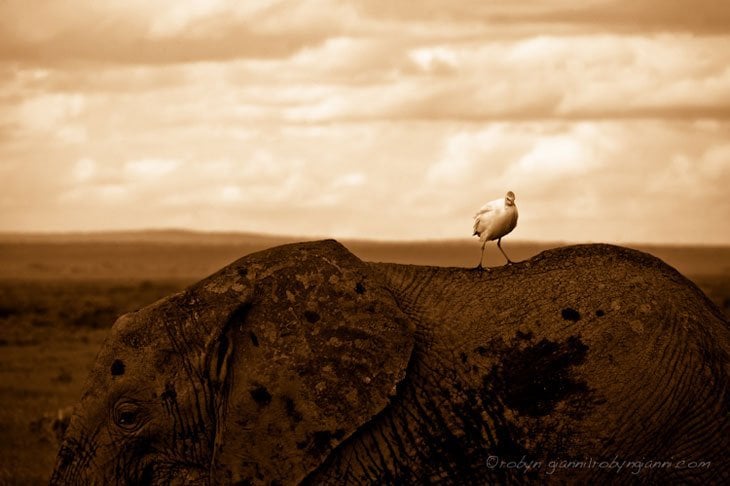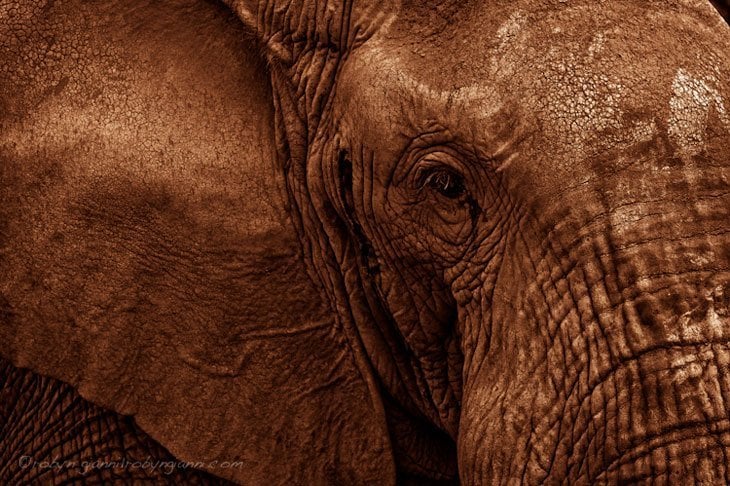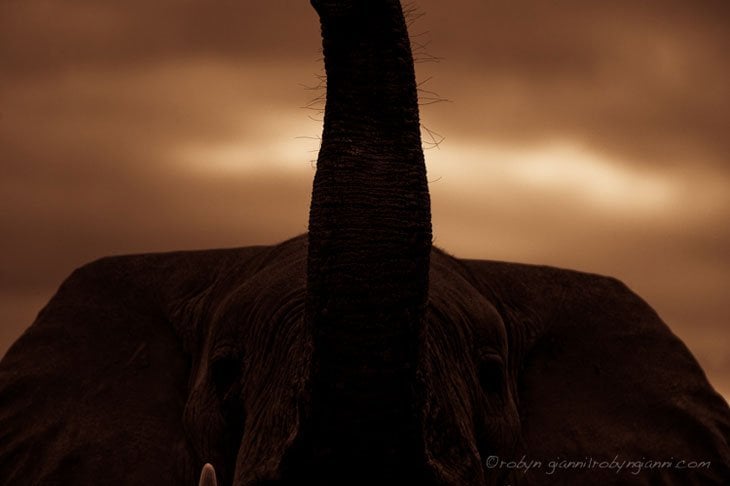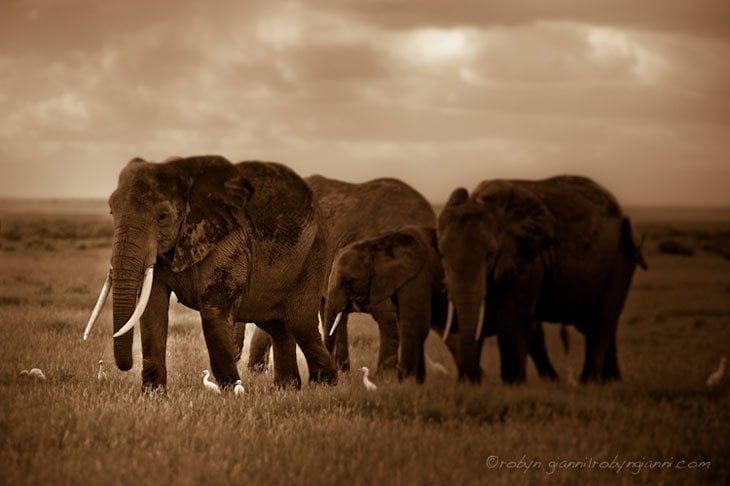I am probably best known for photographing elephants. I have photographed them in Zambia and Zimbabwe, Botswana, Tanzania, and South Africa. In each country the elephants are different. The environment they live in is drastically diverse in each country on the continent of Africa. In Kenya, there is the open land of Amboseli National Park. Here the herds are vast.
On safari, I keep a journal, a sort of photographic notebook. These are all personal memories for me. In each photograph, I wanted to capture the moment as I remember it, as I saw it, and more importantly as I felt it.
East Africa is renowned for its breathtaking wildlife and diverse ecosystems, but perhaps no creature embodies the spirit of this region more than the elephant.
These magnificent animals are the largest land mammals on Earth and play a crucial role in maintaining the health of their environments.

Overview of Elephant Species
In East Africa, the most commonly found elephant species is the African bush elephant (Loxodonta africana), known for its large ears and tusks. These elephants can weigh up to 12,000 pounds and stand up to 13 feet tall at the shoulder.
There’s also the African forest elephant (Loxodonta cyclotis), which is smaller and has straighter tusks. While both species share the same family, they inhabit different environments and exhibit distinct behaviors.
Importance of Elephants in Ecosystems
Elephants are often referred to as ecosystem engineers due to their significant impact on their environments. Their feeding habits help to maintain the vegetation structure in savannas and forests, allowing a variety of species to thrive.
By uprooting trees and trampling underbrush, elephants create open spaces that promote the growth of grasses, benefiting other herbivores and plant species.
Additionally, elephants play a vital role in seed dispersal. Many plants rely on elephants to transport their seeds over large distances, which aids in genetic diversity and the survival of various plant species.

Habitat and Distribution
Key Habitats in East Africa
East Africa boasts a variety of habitats where elephants can be found, from the savannahs of the Serengeti to the lush forests of Uganda and Tanzania. National parks and reserves in these areas provide protected spaces for elephants to roam freely.
Some notable locations include Tsavo National Park in Kenya, which is famous for its large herds, and the Maasai Mara, where elephants can often be seen during the Great Migration.
These habitats are not only crucial for elephants but also support a rich diversity of wildlife, including lions, zebras, and various bird species. Protecting these environments is essential for the survival of elephants and the overall health of the ecosystems.
Migration Patterns and Routes
Elephants in East Africa exhibit unique migration patterns driven by seasonal changes and resource availability. They often travel long distances in search of food and water, particularly during dry seasons when resources become scarce.
This migration can cover hundreds of miles as elephants navigate to different feeding grounds and water sources.

Conservation Challenges
Threats Facing Elephants
Despite their importance, East African elephants face numerous challenges that threaten their survival. Poaching for ivory remains one of the most significant threats. The illegal ivory trade is fuelled by demand in various parts of the world, leading to a devastating decline in elephant populations.
According to reports, tens of thousands of elephants are killed each year for their tusks, which has reached alarming levels.
In addition to poaching, habitat loss due to agriculture, urban development, and climate change further exacerbates the situation. As human populations grow, the encroachment into natural habitats reduces the space available for elephants and other wildlife, leading to increased human-elephant conflicts.
Conservation Efforts in East Africa
Recognizing the urgent need to protect elephants, various organizations and governments have initiated conservation efforts across East Africa. Anti-poaching initiatives, such as increased patrolling and surveillance in national parks, aim to curb illegal hunting.
Community engagement and education also play crucial roles in these efforts, as local communities are encouraged to participate in conservation activities and benefit from ecotourism.
Moreover, international collaboration is essential in tackling the ivory trade. Efforts to strengthen laws and regulations, alongside raising awareness about the importance of elephants, are vital in changing public perception and reducing demand for ivory.
Through these combined efforts, there is hope for the future of East African elephants.
I accidently found myself in the middle of a small group of elephants walking to catch up with the herd that was on the opposite side of where I was sitting.

Elephant Behaviour and Social Structure
Family Dynamics and Herd Structure
Elephants are highly social animals that live in matriarchal herds led by an older female. Herds usually consist of related females and their offspring, providing a stable environment for nurturing young elephants. The matriarch is responsible for making decisions regarding movement, feeding, and protection of the group.
Her wisdom, collected over her many years, helps her to guide the herd towards food and water.
Referred to as cows, females generally stay in their mother’s herd throughout their life. When a female reaches her teenage years, the elders, mother and aunts will all teach and prepare them for motherhood ready for when they themselves become a mother.
This complex social structure fosters strong bonds among the herd members. Young elephants learn essential survival skills from their mothers and other females in the group, such as foraging techniques and social interactions.
Male elephants, referred to as bulls, live their early years in their mother’s herd. Bull elephants will live in the same herd until the age of 12 to 15 years.
When teenagers these young bull elephants go to live in smaller groups of other male elephants. In these small groups, the male elephants learn better ways to interact with other male elephants, meeting older bull elephants on their travels and learn mating etiquettes.
The male elephants travel from one mate to another, therefore keeping gene pool varied, which is vital for good healthy herds.
The number of elephants in the herds can depend on the type of elephant. For comparison, the herd of African Savannah elephants is typically made up of 20 to 70 elephants. On the other hand, African forest elephants and Asia elephants live in smaller herds.
Communication and Social Bonds
Elephants are known for their remarkable communication skills, which include vocalisations, body language, and even infrasound—sounds below the frequency of human hearing. These forms of communication play a vital role in maintaining social bonds and coordinating group movements. For instance, when a matriarch senses danger, she may use low-frequency rumblings to alert the herd.
Beyond vocal communication, elephants also exhibit empathy and emotional intelligence. They have been observed comforting distressed companions and exhibiting behaviors associated with grief when a member of the herd passes away.
Safari Adventures and Viewing Opportunities
One of the most exhilarating ways to experience the majesty of East African elephants is through safari adventures. National parks like Amboseli, Ngorongoro Crater, and Tarangire offer unparalleled opportunities to view elephants in their natural habitats.
Visitors can witness these magnificent creatures up close, observing their behaviors and interactions in the wild, which creates a lasting impression and fosters a deeper appreciation for conservation efforts.
Safari companies often provide guided tours that emphasize responsible wildlife viewing, ensuring that interactions with elephants and their habitats are sustainable. This not only enhances the experience for visitors but also supports local economies and conservation initiatives. Ethical tourism plays a critical role in promoting the protection of elephants and their ecosystems.
Conclusion
With a quick sharp turn, and a head thrown confidently to the side, I am told exactly the way it is. Africa does not belong to me.
The future of elephants in East Africa hangs in the balance, influenced by human activities and the ongoing challenges they face. However, through concerted conservation efforts, community engagement, and global awareness, there is hope for the survival of these majestic creatures.
Protecting their habitats and addressing the root causes of poaching are critical steps that can lead to the recovery of elephant populations.
You may also like:
The Penguins Of Southern Africa
This Is Madagascar!
FAQs
What is the difference between African bush elephants and African forest elephants?
African bush elephants are larger and inhabit savannas, while African forest elephants are smaller and live in dense forests. Their different habitats influence their physical characteristics and behaviours.
Why are elephants important for the ecosystem?
Elephants act as ecosystem engineers by shaping habitats, maintaining vegetation, and promoting biodiversity through seed dispersal.
What are the main threats to East African elephants?
The primary threats include poaching for ivory, habitat loss due to human encroachment, and climate change affecting their migratory routes.








These photos are amazing.
Not only beautiful photos, also I think that is a great post. Well write with true passion about this wonderful animals.
You never get enough watching these gentle giants in amboseli national park. Amazing animals and there are more than 1500 elephants in amboseli which have been studied for more than 30 years by Cynthia Moss team…They say they can now identify each of them by name.
waw amazing,I’ve never seen before.
WoW what an incredible experience and those photos are absolutely beautiful.
Wow! Incredible photos – the sepia effect makes them really atmospheric. Love the close up of the elephant (last photo), they are such beautiful, wise animals.
A flying safari over Amboseli National parke gave me a wonderful view of elephants in the swamps that I can’t get enough of. Though so big, there beauty never ceases to amaze me, thanks for the wonderful pictures 🙂
oooowwwwwww it’s reallllyyy nice i like your picccccccccccc.
you have made be an instant fan….love your photography
what incredible and beautiful photos! unfortunately there not so many pictures like these left…hope they weren’t disturb by any human
Wow. Just wow. Thanks for posting these. Looking at them is liking being taken to a whole other world.
Beautiful!